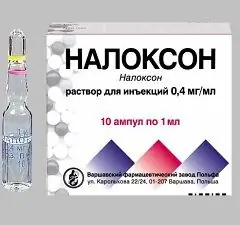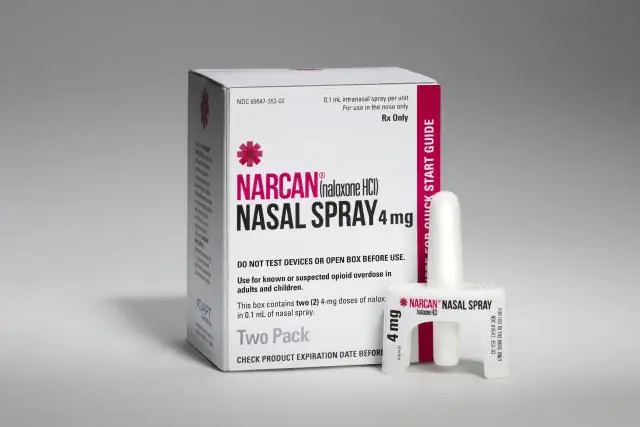- Author Rachel Wainwright [email protected].
- Public 2023-12-15 07:39.
- Last modified 2025-11-02 20:14.
Naloxone
Naloxone: instructions for use and reviews
- 1. Release form and composition
- 2. Pharmacological properties
- 3. Pharmacokinetics
- 4. Indications for use
- 5. Contraindications
- 6. Method of application and dosage
- 7. Side effects
- 8. Overdose
- 9. Special instructions
- 10. Application during pregnancy and lactation
- 11. Use in childhood
- 12. In case of impaired renal function
- 13. For violations of liver function
- 14. Drug interactions
- 15. Analogs
- 16. Terms and conditions of storage
- 17. Terms of dispensing from pharmacies
- 18. Reviews
- 19. Prices in pharmacies
Latin name: Naloxone
ATX code: V03AB15
Active ingredient: naloxone (Naloxone)
Manufacturer: Kern Pharma, S. L. (Kern Pharma, SL) (Spain); Moscow Endocrine Plant FSUE (Russia); Warsaw Pharmaceutical Work Polfa, SA (Poland)
Description and photo update: 2019-26-08
Prices in pharmacies: from 183 rubles.
Buy

Naloxone is a competitive opioid receptor antagonist.
Release form and composition
Dosage form - injection solution: colorless transparent liquid (1 ml each: in glass ampoules without color, 5 pcs. In polyvinyl chloride pallets, in a cardboard box 2 pallets; in ampoules, 5 pcs. In plastic holders, in a cardboard box 2 holders or 10 pcs. In a cardboard box; each box also contains instructions for the use of Naloxone).
The active ingredient of Naloxone is naloxone hydrochloride (in the form of naloxone hydrochloride dihydrate), in 1 ml - 0.4 mg.
Auxiliary components: hydrochloric acid (up to pH 3-5), sodium chloride, water for injection.
Pharmacological properties
Pharmacodynamics
Naloxone is a specific opioid receptor antagonist. The mechanism of its action is due to the ability to competitively bind to the main types of opioid receptors and to eliminate or prevent the peripheral and central (including respiratory depression) action of endogenous opioid peptides and exogenous opioids (narcotic analgesics and their surrogates).
Naloxone also affects the dopaminergic and GABAergic systems of the brain. With drug addiction, it causes the development of withdrawal symptoms. Does not cause addiction and drug dependence.
Clinically significant effects of naloxone: weakening of the hypotensive effect, reduction of sedative and euphorizing effects, restoration of breathing.
The drug does not have a pronounced effect on dystrophy and psychomimetic effects caused by narcotic analgesics of the agonist-antagonist group (for example, pentazocine or butophanol). It is unable to completely reverse the effects of buprenorphine and is ineffective as a tramadol antagonist.
In opioid-dependent patients, naloxone causes withdrawal.
Pharmacokinetics
After intravenous administration of the drug, the effect develops in the first 2 minutes, after intramuscular and subcutaneous administration - within 2-5 minutes. The maximum effect is noted after 5-15 minutes, its duration is 20-45 minutes - with intravenous administration and 2.5-3 hours - with intramuscular / subcutaneous administration.
Naloxone crosses the blood-brain and placental barriers.
It is metabolized in the liver with the predominant formation of glucuronides. It is excreted by the kidneys, while 70% of the administered dose is excreted from the body within 72 hours.
The half-life (T 1/2) from blood plasma is on average 1 hour (from 30 to 80 minutes). T 1/2 in adults - 64 ± 12 minutes, in newborns (after injection into the umbilical vein) - 3.1 ± 0.5 hours, in premature infants - 51.8 ± 9.2 minutes.
Indications for use
- Acute poisoning, including against the background of an overdose of opioid analgesics (fentanyl, trimeperidine, morphine) and other drugs, the toxic effect of which is due to the presence of an opioid component (methadone, opioid surrogates, pentazocine, butorphanol, buprenorphine, nalbuphine) as part of complex measures;
- Postoperative use (only if narcotic analgesics are used during the operation) - to accelerate the recovery from general anesthesia, before the completion of controlled breathing;
- Restoring breathing in newborns, in the case of the administration of opioid analgesics to the mother during childbirth;
- Diagnostic agent for opioid dependence (naloxone test).
Contraindications
Naloxone is contraindicated in case of hypersensitivity to the components of the drug.
The drug should be used with caution in patients with impaired liver and / or kidney function, in children and in newborns.
Appointment during pregnancy and breastfeeding is possible only when urgently needed.
Naloxone, instructions for use: method and dosage
The drug Naloxon is intended for intravenous (i / v), intramuscular (i / m) and subcutaneous (s / c) administration.
The rate of administration is selected individually, taking into account the patient's reaction to the drug and previous single doses.
For infusion use, Naloxone solution should be diluted in 5% dextrose solution or 0.9% sodium chloride solution, observing the proportion of 1 ampoule of the drug per 100 ml of infusion medium. Prepare a solution before direct use.
The dose and method of administration are prescribed by the doctor, taking into account the patient's condition, the type and amount of opioid taken by him.
Recommended dosage for acute poisoning (overdose) with opioid analgesics:
- Adults: initial single dose - 0.4-2 mg. In life-threatening conditions, the drug should be administered intravenously slowly, over 2-3 minutes. To achieve a clinical effect, repeated administration is shown in 2-3 minutes, the procedure is repeated until the restoration of uniform breathing and consciousness. If recovery of consciousness and respiration has not occurred after a total dose of 10 mg, a non-opioid cause of poisoning should be considered. Can be used in / m or s / c;
- Children: the initial single dose is 0.01 mg per 1 kg of the child's weight, preferably intravenous administration for 2-3 minutes. If necessary, repeated administration of a dose of 0.1 mg per 1 kg of body weight is indicated after 2-3 minutes. In case of impossibility of intravenous administration, the drug is administered in fractional doses intramuscularly or subcutaneously with an interval of 2-3 minutes, in this case the effect appears more slowly. To obtain a longer action, a single intramuscular or subcutaneous administration is recommended at a dose of about 0.2 mg or 0.06 mg per 1 kg of the child's weight.
Postoperative use of Naloxone:
- Adults: i.v., 0.1-0.2 mg at intervals of 2-3 minutes until normal pulmonary ventilation appears and the patient wakes up, but in the absence of distinct sensations of discomfort and pain. Symptoms of exceeding the minimum required dose may be an increase in blood pressure (BP), cessation of analgesia, sweating, nausea, vomiting, dyscirculatory crisis. Sometimes, especially in cases of long-acting opioid analgesics, additional intramuscular administration of naloxone is required for 1-2 hours. The drug can also be administered by intravenous infusion;
- Children: in / in at 0.01 mg per 1 kg of weight, in the absence of the desired effect, you can additionally enter a dose corresponding to 0.1 mg per 1 kg of the child's weight. In the absence of the possibility of intravenous administration, fractional intramuscular or subcutaneous administration is indicated every 2-3 minutes. A single dose should not exceed 0.2 mg of the drug. In addition, infusion administration is indicated.
In the case of the use of opioid analgesics during childbirth to restore breathing in newborns, intravenous, intramuscular or subcutaneous administration of Naloxone is indicated. Ensure that the infant's airway is clear before administration. The recommended dose is 0.01 mg per 1 kg of body weight, it is possible to repeat the dose in 2-3 minutes. For prophylaxis, a newborn can enter 0.2 mg once / m or 0.06 mg per 1 kg of body weight.
As a diagnostic tool for drug (opioid) dependence, the drug is used by intravenous administration of a dose of 0.0005 mg per 1 kg of the patient's weight. This dose allows you to establish whether or not the difficulty of urination and respiratory depression are caused by opioids. After that, the dose can be slightly increased, but not to large doses, since high doses completely remove the effect of the opioid, including the analgesic effect, cause excitation of the circulatory system and the sympathetic system.
Side effects
The use of Naloxone in the postoperative period can cause the following side effects: suffocation, increase or decrease in blood pressure, ventricular tachycardia and ventricular fibrillation, pulmonary edema, cardiac arrest (these effects in rare cases can lead to coma and encephalopathy, up to death). The use of doses in excess of the recommended ones can cause psychomotor agitation and the disappearance of analgesia.
Sudden withdrawal of the drug can lead to sweating, nausea, vomiting, pulmonary edema, increased blood pressure, tachycardia, ventricular tachycardia, ventricular fibrillation, cause tremors and body cramps, cardiac arrest, including death.
Withdrawal symptoms in opioid dependence: weakness, nausea, vomiting, fever, sweating, epigastric spasms, diarrhea, increased blood pressure, tachycardia, rhinitis, sneezing, piloerection, nervousness, irritability, yawning, anxiety, trembling, pain of unknown location; in newborns - uncontrollable crying, convulsions, hyperreflexia.
Overdose
No cases of acute overdose have been reported.
With the introduction of Naloxone in high doses (from 4 mg / kg), the following symptoms are possible: chills, nausea, vomiting, a marked decrease or increase in blood pressure, bradycardia, hyperventilation, convulsions. Conservative treatment in intensive care is shown.
At a dose of 2 mg / kg, the drug can cause cognitive and behavioral impairments, including lack of appetite, tension, anxiety, depression, suspicion, irritability, difficulty concentrating. Behavioral symptoms can last for 2-3 days.
It is also possible to develop somatic signs, such as stomach pain, feeling of heaviness, nausea, sweating, dizziness.
Treatment is symptomatic.
special instructions
The drug Naloxone is used in inpatient conditions, provided with the possibility of resuscitation measures (including cardiopulmonary measures) and oxygen therapy.
Neonates should be treated with caution if the mother has a history of opioid dependence, since a complete abrupt withdrawal of the drug can potentiate the development of acute withdrawal.
Patients with pathology of the lungs, heart, impaired renal and / or liver function, suspected or established physical dependence on opioids, during pregnancy, breastfeeding, in childhood, it is recommended to use the drug under close medical supervision.
Since the response to the use of Naloxone in the treatment of respiratory depression while taking buprenorphine may be incomplete and there is a risk of decreased respiratory activity, the patient may need mechanical ventilation.
Influence on the ability to drive vehicles and complex mechanisms
During the period of naloxone use, the patient is prohibited from any activity related to the management of vehicles and mechanisms.
Application during pregnancy and lactation
During pregnancy and lactation, Naloxone may be prescribed if urgently needed.
Pediatric use
In pediatrics, the use of Naloxone is allowed if indicated. Care should be taken to prescribe the drug in doses taking into account the child's age.
Caution must be exercised when treating newborns whose mothers have a history of opioid dependence, since complete and abrupt withdrawal of the drug can cause acute withdrawal.
With impaired renal function
Naloxone should be used with caution in patients with impaired renal function.
For violations of liver function
Naloxone should be used with caution in patients with impaired liver function.
Drug interactions
When administered intravenously, Naloxone should not be mixed with other agents, and the drug is also incompatible with solutions containing bisulfites.
The drug reduces the hypotensive effect of clonidine, the effect of opioid analgesics (nalbuphine, butorphanol, pentazocine, remifentanil, fentanyl), which helps to accelerate the onset of withdrawal syndrome.
The simultaneous use of methohexital blocks the acute period of abstinence that arose during the use of naloxone in patients with drug addiction.
Compatible with 5% dextrose solution, 0.9% sodium chloride solution and sterile water for injection.
Analogs
Naloxone analogs are Antaxon, Vivitrol, Naltrexon, Naltrexon FV, Prodetoxon, Relistor, etc.
Terms and conditions of storage
Keep out of the reach of children.
Store in a dark place at temperatures up to 25 ° C.
Shelf life is 4 years.
Terms of dispensing from pharmacies
Dispensed by prescription.
Reviews about Naloxone
Reviews of Naloxone are few, but mostly positive. Some patients worry that the drug may cause health problems that are delayed. However, according to reports, this is not happening.
Doctors speak positively about Naloxone. They argue that the drug is helping to save lives of many patients in case of accidental and deliberate overdoses of analgesics and / or opioids. In addition, this drug allows you to identify latent drug addiction.
The price of Naloxone in pharmacies
On average, the price of Naloxone is 200 rubles. for 10 ampoules of solution for injection 0.4 mg / ml.
Naloxone: prices in online pharmacies
|
Drug name Price Pharmacy |
|
Naloxone solution for in. 0.4mg / ml 1ml 10 pcs. 183 r Buy |
|
Naloxone 0.4 mg / ml solution for injection 1 ml 10 pcs. 183 r Buy |

Maria Kulkes Medical journalist About the author
Education: First Moscow State Medical University named after I. M. Sechenov, specialty "General Medicine".
Information about the drug is generalized, provided for informational purposes only and does not replace the official instructions. Self-medication is hazardous to health!






